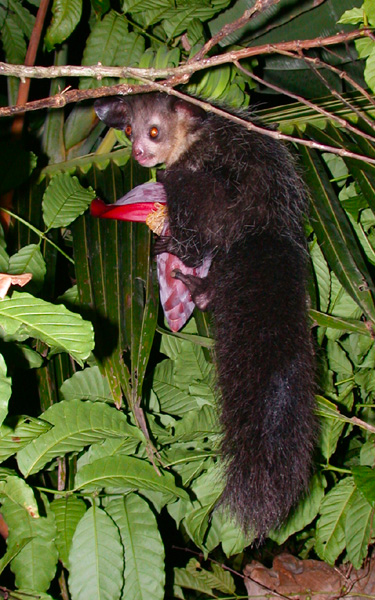
I’ve been playing a lot of the most recent Pokémon game recently. And let me tell you, there are a lot of cool new Pokémon in it! There’s a dog made of bread, a ghost dog, a mastiff dog…can you tell I like dogs?
One Pokémon I’m not as enamored with is Grafaiai. It’s a weird, monkey-like thing with long, neon-blue middle fingers. It just…doesn’t do it for me.
But I am a huge fan of the real-life animal it’s modeled after: the aye-aye (Daubentonia madagascariensis). This mostly solitary species lives exclusively on the island of Madagascar, off the coast of Africa. And boy, it’s a weird animal.

What is it?
At first glance, it’s hard to tell precisely what kind of animal aye-ayes are. Early naturalists had issues, too; they were initially classified as rodents.
However, we’re sure today that aye-ayes are a type of lemur (the primates who live exclusively in Madagascar). The story goes that an ancestral primate rafted from Madagascar millions of years ago. This ancestor eventually evolved into the over 100 lemur species we know today.
Now, where does the name ‘aye-aye’ come from? One story says it’s from French naturalist Pierre Sonnerat, who claimed the name is a ‘cry of exclamation and astonishment.’ However, the Malagasy name ‘hai hai’ or ‘hay hay’ is used throughout Madagascar. This suggests that ‘aye-aye’ is not from Sonnerat but instead does come from the Malagasy name for the animal.
Weird body
Part of the confusion over where to categorize aye-ayes is due to their body: aye-ayes just look weird.
Let’s start with their face. Aye-ayes have huge eyes, which serve as an adaption for their lifestyle as the world’s largest nocturnal primate. They also have huge ears. In fact, aye-ayes have the largest ears compared to their body size for any primate. These ears help an aye-aye hear their food (grubs and insects) underneath tree bark. These features, along with their head shape, make aye-ayes seem cat-like.
However, aye-ayes also have teeth that never stop growing. This is a common feature in rodents (and super weird for lemurs), which explains why early naturalists first classified aye-ayes as rodents.
Aye-ayes also have toes, fur coloring, and a tail similar to squirrels.

About those fingers…
And, of course, aye-ayes have weird hands and fingers.
First, aye-ayes have pointed claws on all their fingers and toes except for their opposable big toes, which have nails. These claws help an aye-aye dangle in the trees.
Aye-ayes also have a 6th finger – a pseudo thumb. In between their thumb and their wrist, aye-ayes have a tiny nub of bone. This nubby bone can move towards and away from the other fingers and toward the palm. It seems that this pseudo thumb evolved to help aye-ayes grip tree limbs.
Why does it need help? Because the aye-aye’s middle finger became so skinny, using it to travel would snap it under the aye-aye’s weight.
The middle finger
The middle finger is the aye-aye’s strangest finger.
This finger is very long and skinny. Unique in the animal kingdom, the aye-aye’s middle finger has a ball-and-socket joint. These are the same joints we have in our shoulders and hips, allowing the aye-aye to rotate and swivel its middle finger in any direction.
This makes the middle finger great for one thing: foraging.
Aye-ayes are omnivores and eat a mix of fruit, nectar, and insects. Aye-ayes use what is called ‘percussive foraging’ to hunt insects. Like a woodpecker, aye-ayes hit tree trunks and branches, listening for the hollow sounds that indicate an insect has been feasting under the bark. The middle finger can tap very quickly, up to 8 times a second! Once an insect is found, the aye-aye’s long middle finger can also scoop them out.

Guess what else that finger’s used for
If you guessed picking noses, you’d be right!
A recent paper in the Journal of Zoology reported that aye-ayes use their long middle finger to pick their nose. And yes, they eat the boogers, too. Don’t believe me? You can watch the video evidence here.
How far back does that finger reach? Pretty far back, according to the researchers. They did a CT scan of an aye-aye’s head and middle finger to model nose-picking – the middle finger can reach entirely through the nasal cavity and into the throat.
Aye-ayes bring the number of species that we’ve seen pick their noses up to 12 (yes, this number includes humans). This raises some interesting questions: Are there other species doing it too? And why are animals picking their noses? The answer to the first question is probably yes. As for the second question, there are a few hypotheses. It’s totally possible that nose-picking just feels good! But it’s also possible that picking your nose and eating the boogers helps boost your immune system. Looks like there’s an area ripe for future research!
Bad luck?
Although aye-ayes are absolutely harmless (unless you’re a grub), many native Madagascar people see the aye-aye as an omen of bad luck. Which, fair. It’s a creepy-looking creature!
Some superstitions claim that the aye-aye is a harbinger of evil and death and must be killed on site. Others think that if an aye-aye points at you with its creepy middle finger, you’re marked for death. Some even go so far as to believe that aye-ayes sneak into houses and murder sleeping people by puncturing the victim’s aorta with their middle finger.
All of these beliefs are not true. Sure, the aye-aye looks creepy. But underneath the big ears, orange eyes, and weird fingers is just an animal that likes eating its boogers.
Resources

Leave a Reply